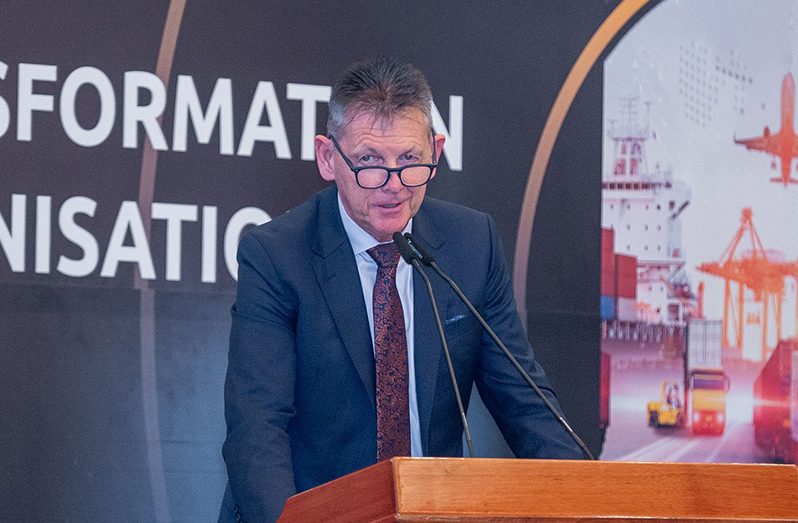–Mallon responds to critics by outlining company’s century-long expertise in pipeline construction, operation
–points to project’s potential to bring sustainable benefits to the nation, while maintaining strong commitment to safety, environmental standards
GUYANA stands at the cusp of a sustainable future with ExxonMobil’s activities in the region not only promising continued economic growth, but also a balanced approach to environmental stewardship and social responsibility for generations to come.
This was according to ExxonMobil’s President of Upstream, Liam Mallon, during his address at the Guyana Energy Conference and Supply Chain Expo at the Marriott Hotel, on Monday.
While addressing the attendees, Mallon outlined the company’s significant advancements in sustainable energy development, focusing particularly on the transformative Gas to Energy Project and its broader implications for Guyana and the global energy market.
Reflecting on the journey since 2015, Mallon celebrated the exponential growth in oil production in the Stabroek Block, now producing almost 645,000 barrels a day, a substantial increase from 370,000 barrels just a year prior.
“It is a phenomenal achievement, something that we are extraordinarily proud of every day,” he said, emphasising the efficiency and environmental standards guiding the operation of the floating production, storage and offloading (FPSO) vessels Unity, Destiny, and Prosperity.
Mallon highlighted the project’s rapid transition from discovery to development, achieved in less than half the time typically seen in the industry.
This acceleration, coupled with environmental achievements such as achieving background flaring in just 39 days on Prosperity, showcases ExxonMobil’s commitment to sustainable development.
Mallon highlighted the substantial progress and benefits of the ambitious Gas to Energy Project, while addressing and countering critics’ concerns.
He detailed the advancements in the 140-mile pipeline project aimed at connecting the Liza wells to Guyana’s mainland.
Mallon also outlined the project’s potential to significantly cut the electricity bills of Guyanese citizens and reduce the country’s carbon emissions.
“As we move towards shore, we’re well on our way to completing the 140-mile Gas to Energy pipeline,” Mallon said, highlighting the initiative’s alignment with the government’s vision to boost economic growth while enhancing environmental sustainability.
The project, which involves laying a 200km, 12-inch diameter pipeline, will channel natural gas from the Liza Phase One and Phase Two FPSO vessels to a state-of-the-art power plant and Natural Gas Liquids (NGL) facility in Wales.
Esso Exploration and Production Guyana Limited (EEPGL), along with its co-venturers in the Stabroek Block, are behind the pipeline’s construction, which has an estimated cost of US$1 billion and is cost recoverable.
The Government of Guyana has earmarked $80 billion in the 2024 budget for the project, highlighting its significance to national development.
The ExxonMobil executive addressed critics’ concerns regarding the project’s safety and environmental implications.
Mallon reassured stakeholders of the company’s century-long expertise in pipeline construction and operation, highlighting a robust track record of safe, reliable, and responsible energy development.
“2024 marks the 100th anniversary of our company’s first long-distance welded pipeline. We’ve been doing this for a century. We know how to do it safely, reliably, and responsibly,” Mallon articulated, aiming to mitigate fears surrounding the pipeline’s impact.
Additionally, he pointed out the project’s role in fostering a transition to cleaner energy sources in Guyana.
By replacing imported fuel oil with domestic natural gas, the Gas to Energy project is expected to offer significant environmental benefits, including a reduction in greenhouse gas emissions.
This initiative is part of a broader strategy to balance energy production with environmental protection, a stance Mallon described as central to ExxonMobil’s operations.
His address also touched on the broader effects of the project on Guyana’s development, portraying it as a catalyst for economic growth and energy security.
Mallon painted a picture of a burgeoning onshore sector stimulated by the energy project, with new businesses, infrastructure, and job opportunities emerging as direct and indirect benefits of the initiative.
In response to skepticism, Mallon invoked a Guyanese proverb: ‘Don’t fly past your nest,’ to encapsulate ExxonMobil’s approach towards cautious and measured development.
He assured stakeholders that the company’s pace and practices in bringing the Gas to Energy project online were testament to its capabilities and commitment to safety, as well as to the government’s effectiveness in facilitating necessary reviews and approvals without undue delays.
ENERGY REVOLUTION
As Guyana stands on the brink of an energy revolution, Mallon reassured the public and stakeholders of the Gas to Energy project’s potential to bring sustainable benefits to the nation while maintaining a strong commitment to safety and environmental standards.
The initiative, he said, represents a significant step forward in Guyana’s journey towards sustainable development, energy independence, and a greener future.
He underscored the multifaceted benefits of this project to the conference, from economic to environmental, heralding a new era of energy efficiency and sustainability for Guyana.
Onshore, the ripple effects of ExxonMobil’s activities are evident in burgeoning business activities, infrastructural development, and job creation, marking a period of vibrant growth and opportunity.
“For me personally, I started this journey in 2015 in this country, and I’ve had the good fortune of being able to stay with it through this phenomenal period of growth,” Mallon reflected, underscoring the transformative impact on the nation’s landscape.
Addressing global challenges, Mallon pointed to Guyana’s pivotal role in stabilising energy markets amid geopolitical unrest.
He credited the nation’s burgeoning energy sector, alongside contributions from the United States, Canada, and Brazil, with averting the typical spikes in energy prices during crises.
“The outsized influence that Guyana observes on the world stage is due to the extraordinarily successful energy development,” he asserted, signalling the country’s ascending role in global energy dynamics.
Mallon also highlighted the commitment to environmental protection, highlighting initiatives to eliminate flaring and reduce emissions.
He again portrayed the Gas to Energy Project as a cornerstone in Guyana’s strategy to balance energy production with environmental sustainability.
In terms of human capital, ExxonMobil’s engagement has translated into significant employment and growth opportunities for Guyanese citizens and businesses.
Mallon pointed to the Greater Guyana Initiative, which is a 10-year, US$100 million programme funded by ExxonMobil and its co-venturers Hess and CPGL, aimed at developing the local workforce, building human capacity, advancing education, and improving healthcare in Guyana.
He also pointed to the recent commissioning of Guyana’s first state-of-the-art US$13 million (GY$2.6B) oil and gas training facility – The FacTor (Facility Simulator) – at Port Mourant, Berbice, Region Six.
The facility is the result of a collaborative effort between the Guyana government and ExxonMobil, and represents a significant step towards realising the government’s vision of transforming the region into an educational and investment hub, contributing to the nation’s economic growth.
“We’re taking sustainable actions to maximise the capacity of Guyanese workers,” Mallon noted, underscoring the commitment to fostering a sustainable development model that extends beyond oil and gas.
Mallon’s address concluded with a reaffirmation of ExxonMobil’s dedication to safety, environmental protection, and collaborative growth, which is prudent energy development, setting a benchmark for partnerships and progress in Guyana and beyond.












